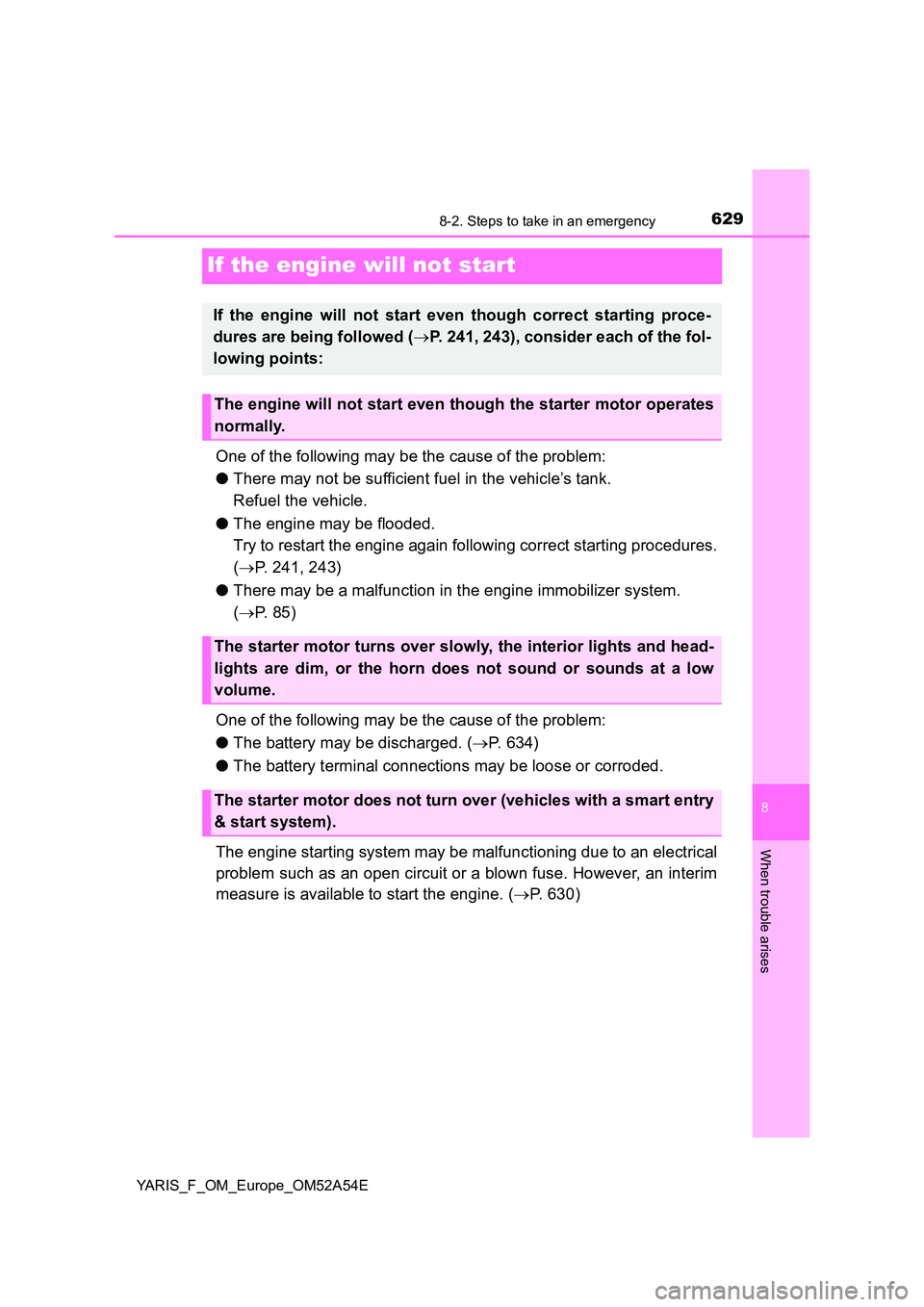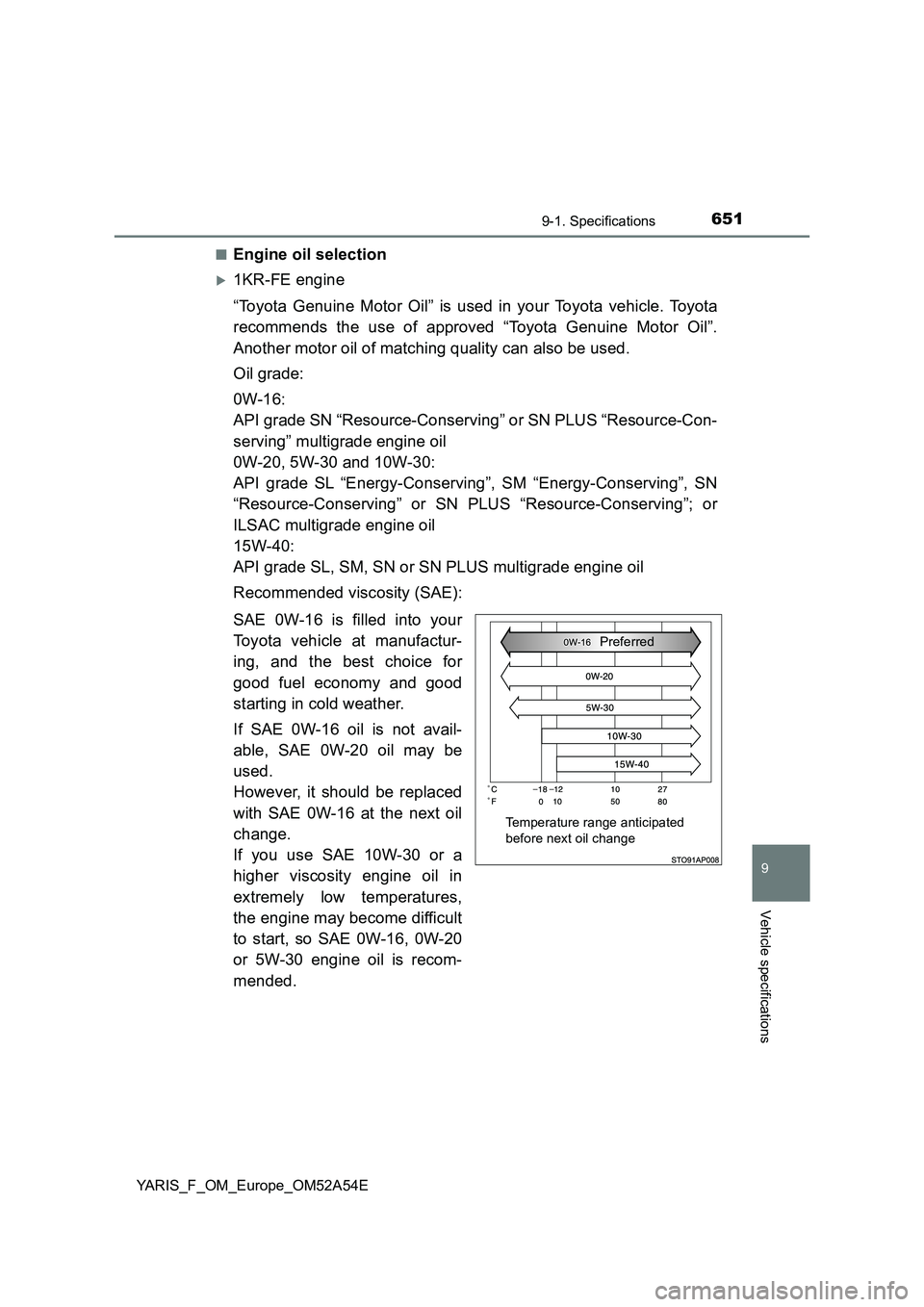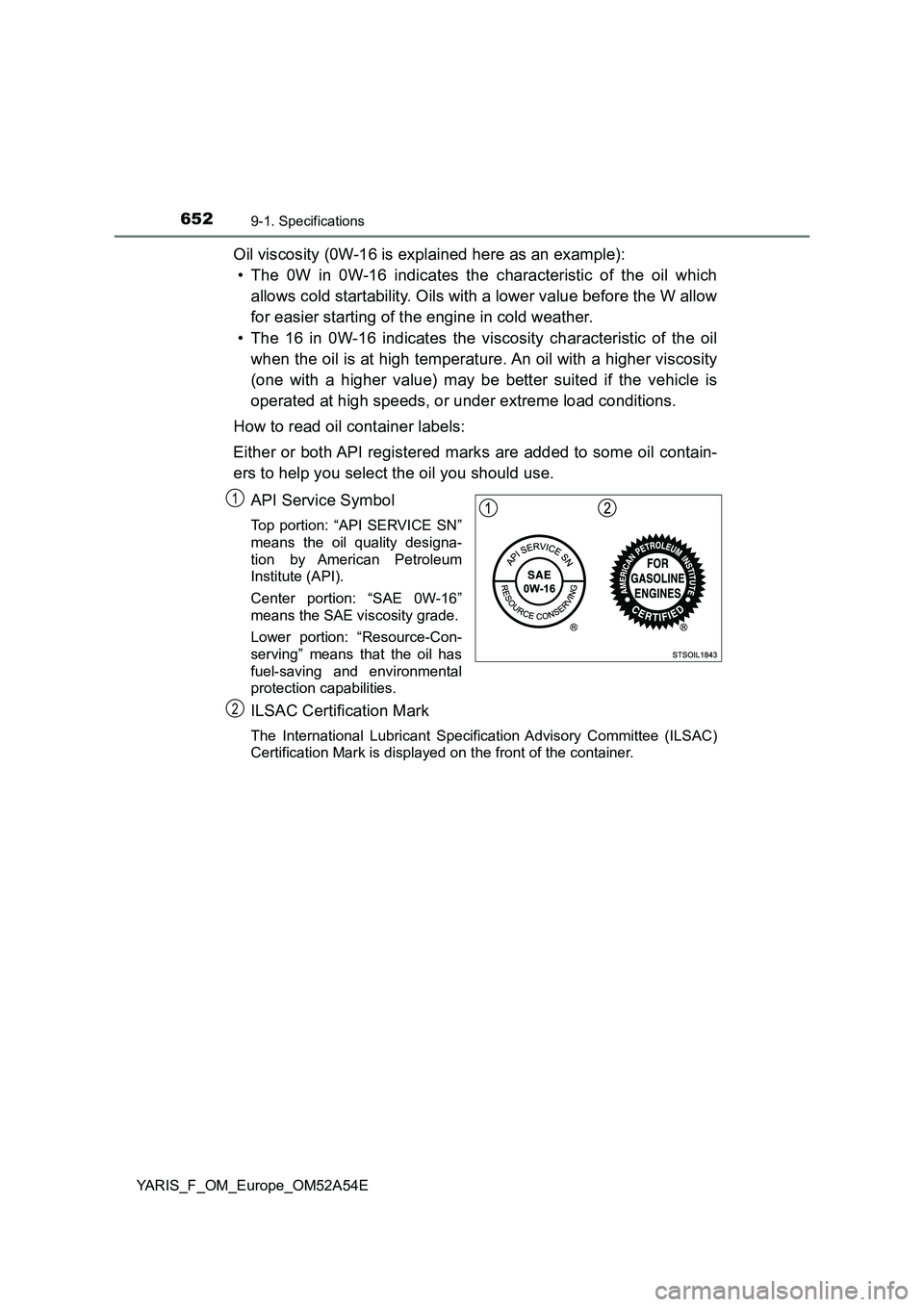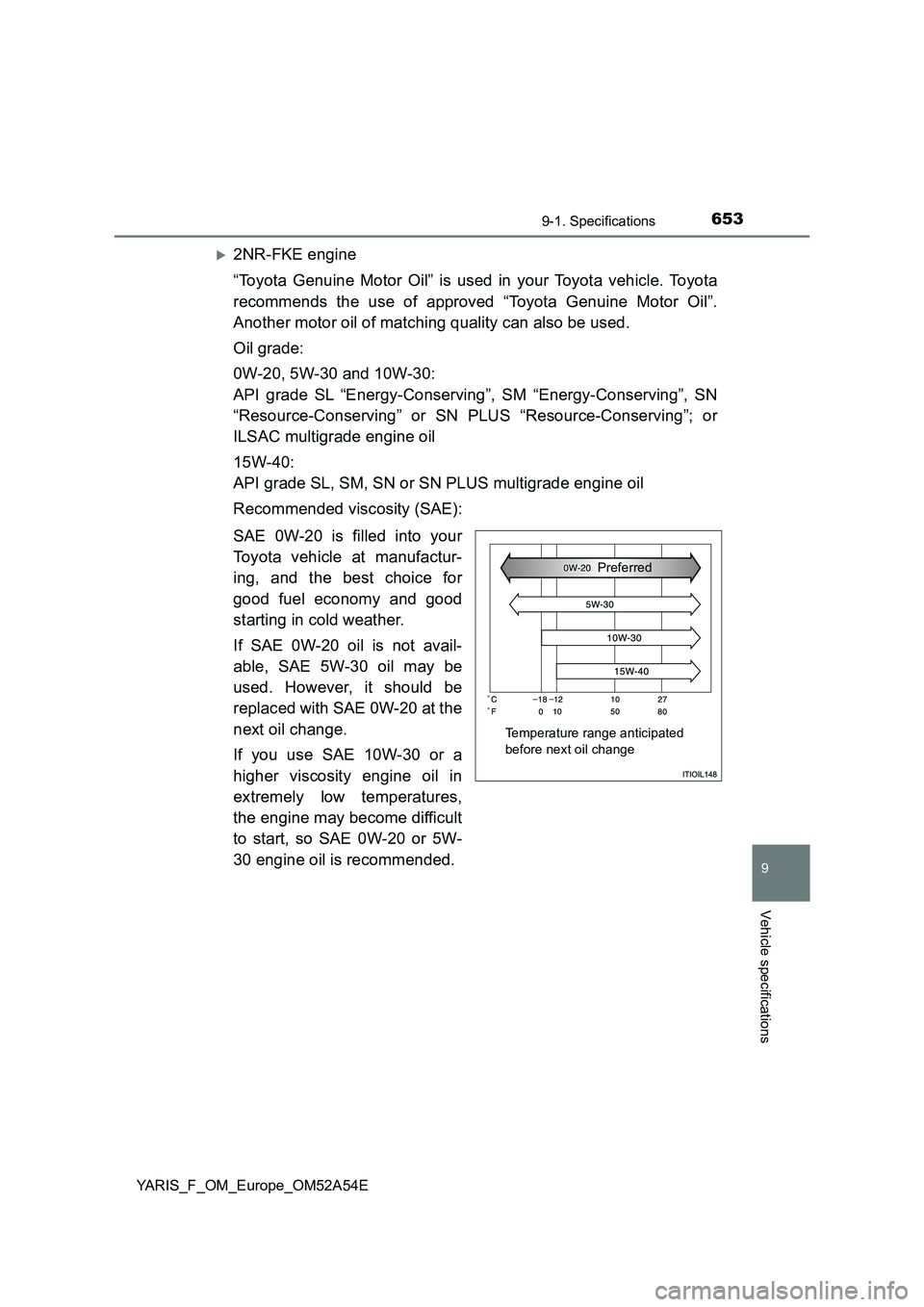Page 587 of 692

5878-2. Steps to take in an emergency
8
When trouble arises
YARIS_F_OM_Europe_OM52A54E
■Passenger detection sensor and passenger seat belt reminder
● If luggage is placed on a passenger seat, the passenger detection sensor
may cause the warning light to flash even if a passenger is not sitting in the
seat.
● If a cushion is placed on the seat, the sensor may not detect a passenger,
and the warning light may not operate properly.
■ Warning light operations for unfastened rear passenger seat belts
● When opening and closing the rear door, the warning light comes on for
approximately 34 seconds.
● When any of the rear seat belts are unfastened, the warning light comes on.
When the rear doors are opened and closed while the warning light is on,
the warning light will turn off after approximately 34 seconds.
■ If the malfunction indicator lamp comes on while driving
For some models, the malfunction indicator lamp will come on if the fuel tank
becomes completely empty. If the fuel tank is empty, refuel the vehicle imme-
diately. The malfunction indicator lamp will go off after several trips.
If the malfunction indicator lamp does not go off, contact any authorized
Toyota retailer or Toyota authorized repai rer, or any reliable repairer as soon
as possible.
■ Warning buzzer
In some cases, the buzzer may not be heard because of noisy place or an
audio sound.
■ Electric power steering system warning light (warning buzzer)
When the battery charge becomes insufficient or the voltage temporarily
drops, the electric power steering system warning light may come on and the
warning buzzer may sounds.
Page 629 of 692

6298-2. Steps to take in an emergency
8
When trouble arises
YARIS_F_OM_Europe_OM52A54E
If the engine will not start
One of the following may be the cause of the problem:
● There may not be sufficient fuel in the vehicle’s tank.
Refuel the vehicle.
● The engine may be flooded.
Try to restart the engine again following correct starting procedures.
( P. 241, 243)
● There may be a malfunction in the engine immobilizer system.
( P. 8 5 )
One of the following may be the cause of the problem:
● The battery may be discharged. (P. 634)
● The battery terminal connections may be loose or corroded.
The engine starting system may be malfunctioning due to an electrical
problem such as an open circuit or a blown fuse. However, an interim
measure is available to start the engine. ( P. 630)
If the engine will not start even though correct starting proce-
dures are being followed ( P. 241, 243), consider each of the fol-
lowing points:
The engine will not start even though the starter motor operates
normally.
The starter motor turns over slowly, the interior lights and head-
lights are dim, or the horn does not sound or sounds at a low
volume.
The starter motor does not turn over (vehicles with a smart entry
& start system).
Page 645 of 692
645
9Vehicle specifications
YARIS_F_OM_Europe_OM52A54E9-1. Specifications
Maintenance data
(fuel, oil level, etc.)........... 646
Fuel information ................. 664
9-2. Customization
Customizable features ....... 666
9-3. Items to initialize
Items to initialize ................ 673
Page 646 of 692
6469-1. Specifications
YARIS_F_OM_Europe_OM52A54E
Maintenance data (fuel, oil level, etc.)
Dimensions and weights
Overall length 3945 mm (155.3 in.)
Overall width 1695 mm (66.7 in.)
Overall height*11510 mm (59.4 in.)
1520 mm (59.8 in.)
*2
1530 mm (60.2 in.)*3
Wheelbase 2510 mm (98.8 in.)
Tread
Front1485 mm (58.5 in.)
*4
1475 mm (58.1 in.)*5
1470 mm (57.9 in.)*6
1465 mm (57.6 in.)*7
1460 mm (57.4 in.)*8
Rear1470 mm (57.9 in.)
*4
1460 mm (57.5 in.)*9
1455 mm (57.2 in.)*7
1445 mm (56.8 in.)*8
Gross vehicle
mass1KR-FE engine 1450 kg (3197 lb.)
2NR-FKE engine 1545 kg (3406 lb.)
Maximum
permissible
axle capacityFront
1KR-FE engine
825 kg (1819 lb.)
2NR-FKE engine
850 kg (1874 lb.)
Rear 825 kg (1819 lb.)
Drawbar load 50 kg (110 lb.)
Page 650 of 692
6509-1. Specifications
YARIS_F_OM_Europe_OM52A54E■
Oil capacity (Drain and refill — reference*)
*: The engine oil capacity is a reference quantity to be used when changing
the engine oil. Warm up and turn off the engine, wait more than 5 minutes,
and check the oil level on the dipstick.
Fuel
Fuel type
When you find these types of fuel label at the
gas station, use only the fuel with one of the fol-
lowing labels.
EU area:
Unleaded gasoline conforming to European
standard EN228 only
Except EU area:
Unleaded gasoline only
Research Octane
Number95 or higher
Fuel tank capacity
(Reference)42 L (11.1 gal., 9.2 Imp.gal.)
Lubrication system
With filter1KR-FE engine
2.8 L (3.0 qt., 2.5 Imp.qt.)
2NR-FKE engine
3.3 L (3.5 qt., 2.9 Imp.qt.)
Without filter1KR-FE engine
2.6 L (2.7 qt., 2.3 Imp.qt.)
2NR-FKE engine
3.0 L (3.2 qt., 2.6 Imp.qt.)
Page 651 of 692

6519-1. Specifications
9
Vehicle specifications
YARIS_F_OM_Europe_OM52A54E■
Engine oil selection
1KR-FE engine
“Toyota Genuine Motor Oil” is used in your Toyota vehicle. Toyota
recommends the use of approved “Toyota Genuine Motor Oil”.
Another motor oil of matching quality can also be used.
Oil grade:
0W-16:
API grade SN “Resource-Conserving” or SN PLUS “Resource-Con-
serving” multigrade engine oil
0W-20, 5W-30 and 10W-30:
API grade SL “Energy-Conserving”, SM “Energy-Conserving”, SN
“Resource-Conserving” or SN PLUS “Resource-Conserving”; or
ILSAC multigrade engine oil
15W-40:
API grade SL, SM, SN or SN PLUS multigrade engine oil
Recommended viscosity (SAE):
SAE 0W-16 is filled into your
Toyota vehicle at manufactur-
ing, and the best choice for
good fuel economy and good
starting in cold weather.
If SAE 0W-16 oil is not avail-
able, SAE 0W-20 oil may be
used.
However, it should be replaced
with SAE 0W-16 at the next oil
change.
If you use SAE 10W-30 or a
higher viscosity engine oil in
extremely low temperatures,
the engine may become difficult
to start, so SAE 0W-16, 0W-20
or 5W-30 engine oil is recom-
mended.
Preferred
Temperature range anticipated
before next oil change
Page 652 of 692

6529-1. Specifications
YARIS_F_OM_Europe_OM52A54E
Oil viscosity (0W-16 is explained here as an example):
• The 0W in 0W-16 indicates the characteristic of the oil which
allows cold startability. Oils with a lower value before the W allow
for easier starting of the engine in cold weather.
• The 16 in 0W-16 indicates the viscosity characteristic of the oil
when the oil is at high temperature. An oil with a higher viscosity
(one with a higher value) may be better suited if the vehicle is
operated at high speeds, or under extreme load conditions.
How to read oil container labels:
Either or both API registered marks are added to some oil contain-
ers to help you select the oil you should use.
API Service Symbol
Top portion: “API SERVICE SN”
means the oil quality designa-
tion by American Petroleum
Institute (API).
Center portion: “SAE 0W-16”
means the SAE viscosity grade.
Lower portion: “Resource-Con-
serving” means that the oil has
fuel-saving and environmental
protection capabilities.
ILSAC Certification Mark
The International Lubricant Specification Advisory Committee (ILSAC)
Certification Mark is displayed on the front of the container.
1
2
Page 653 of 692

6539-1. Specifications
9
Vehicle specifications
YARIS_F_OM_Europe_OM52A54E
2NR-FKE engine
“Toyota Genuine Motor Oil” is used in your Toyota vehicle. Toyota
recommends the use of approved “Toyota Genuine Motor Oil”.
Another motor oil of matching quality can also be used.
Oil grade:
0W-20, 5W-30 and 10W-30:
API grade SL “Energy-Conserving”, SM “Energy-Conserving”, SN
“Resource-Conserving” or SN PLUS “Resource-Conserving”; or
ILSAC multigrade engine oil
15W-40:
API grade SL, SM, SN or SN PLUS multigrade engine oil
Recommended viscosity (SAE):
SAE 0W-20 is filled into your
Toyota vehicle at manufactur-
ing, and the best choice for
good fuel economy and good
starting in cold weather.
If SAE 0W-20 oil is not avail-
able, SAE 5W-30 oil may be
used. However, it should be
replaced with SAE 0W-20 at the
next oil change.
If you use SAE 10W-30 or a
higher viscosity engine oil in
extremely low temperatures,
the engine may become difficult
to start, so SAE 0W-20 or 5W-
30 engine oil is recommended.
Temperature range anticipated
before next oil changePreferred